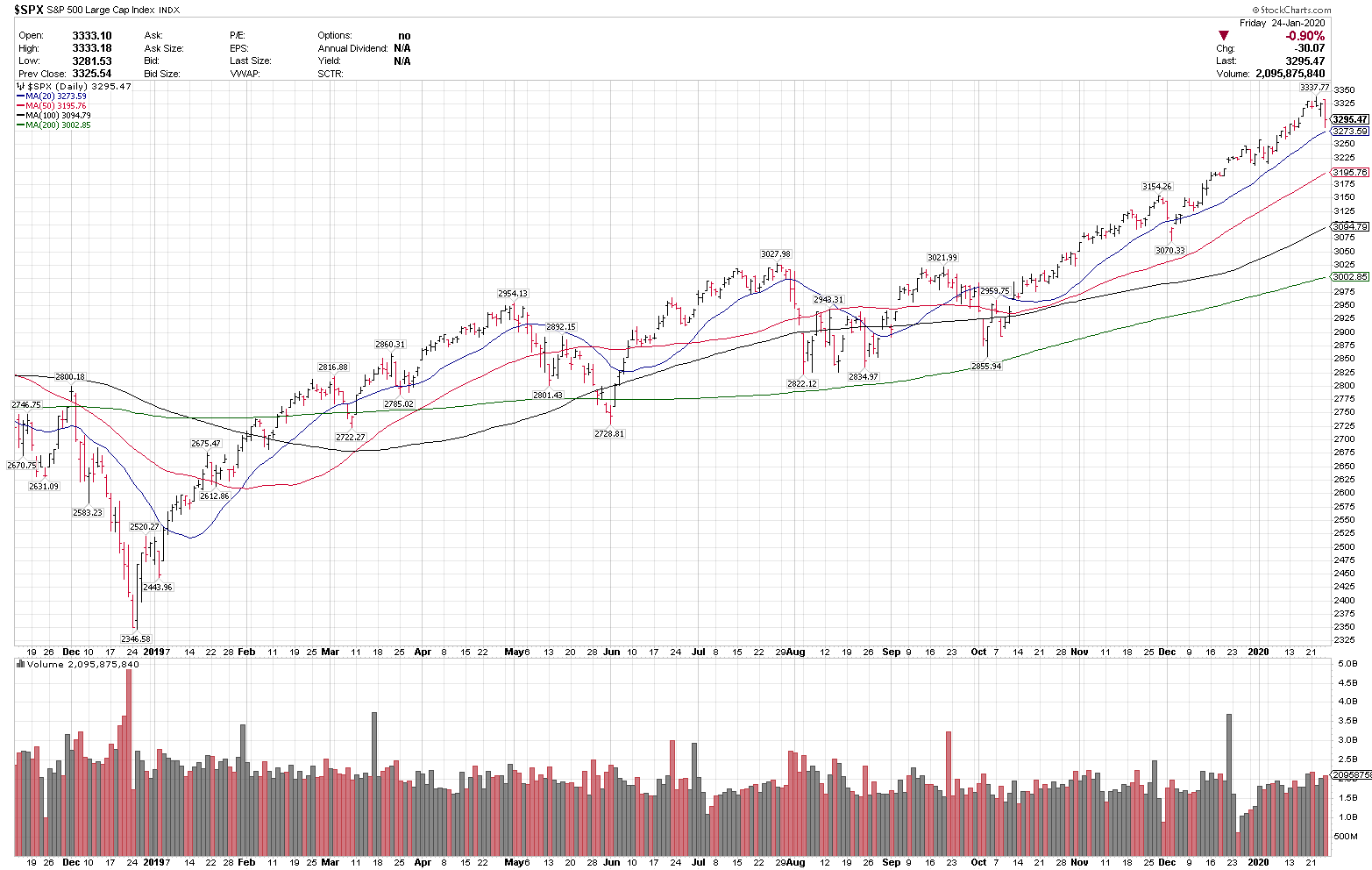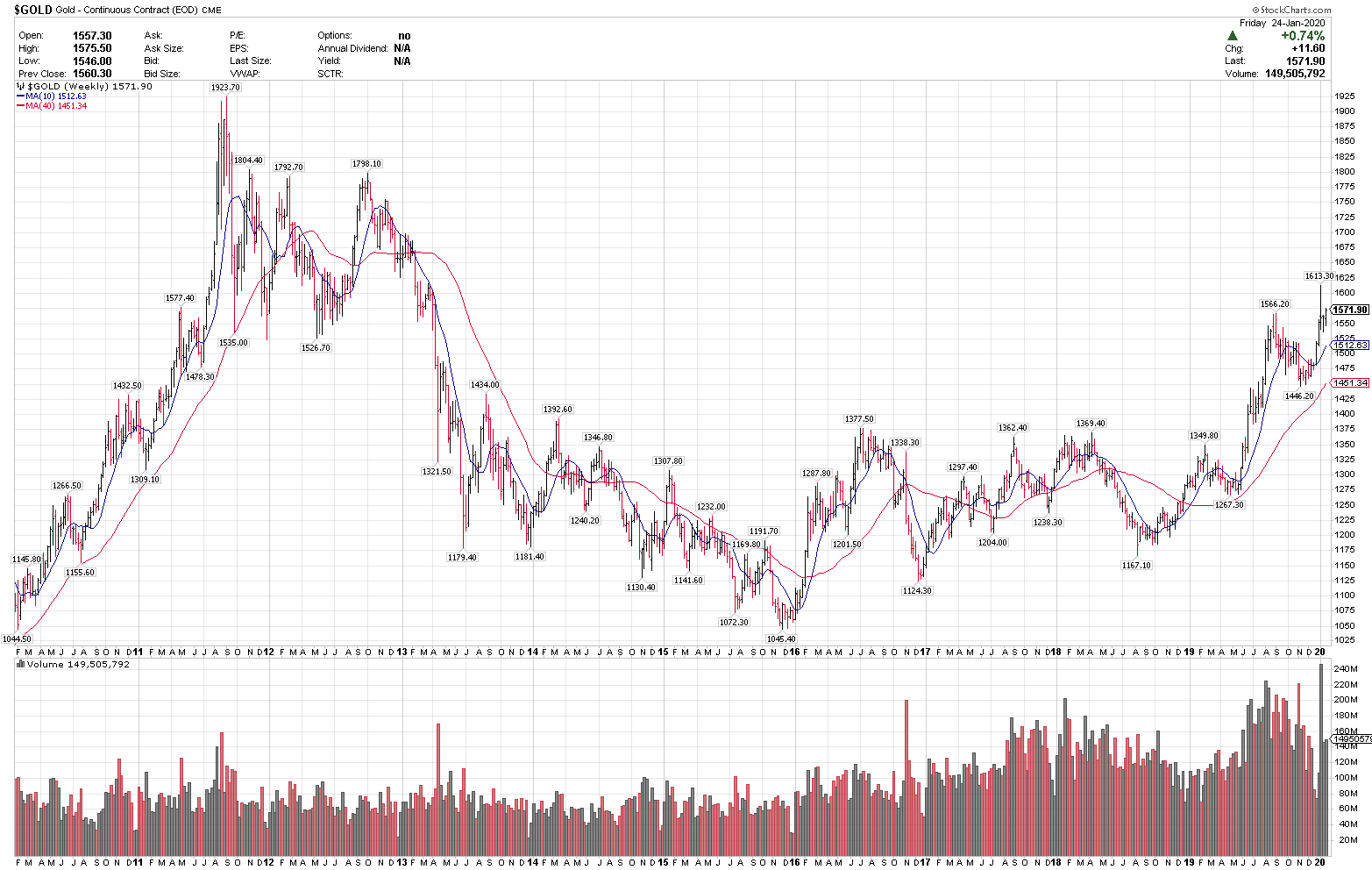 It pays to know when it is time to switch the focus from offense to defense. Right now may be one of those times. $SPX volatility spiked on Friday, as bond yields broke down and Gold made a 7-year weekly closing high.
It pays to know when it is time to switch the focus from offense to defense. Right now may be one of those times. $SPX volatility spiked on Friday, as bond yields broke down and Gold made a 7-year weekly closing high.
Market Volatility is a standard component of trading and investing. Two years ago, almost to the day, on January 24, 2018, I penned this ‘Market Pullback’ blog https://bluechipdaily.com/10-steps-pullback/ that turned out to be very timely, as there was a broad market pullback of 10% within two weeks.
*This Blog is a preview of our Members only Blog posted this morning. There is also an 18 minute video produced by Larry Tentarelli which accompanies the Members version.
With this Blog, I am not predicting a pullback, because I don’t make market predictions, I trade price. With that being said, we are at an interesting juncture here, with markets near all-time highs, and volatility very subdued, as indicated by recent VIX, Put/Call, and daily ATR readings. Yesterday’s mild .90% drop in the S&P 500, while not outsized in any way, could be a signal of heightened volatility to come when taken into context with Gold and Treasuries.

A few factors are at play this week:
1/ The Coronavirus health issue, is getting heavy news coverage, and as with any health issue, has unpredictable news flow. Markets don’t like uncertainty that can’t be quantified by traditional measures, and as a result issues like this can prompt preemptive selling as many make the decision to reduce risk until there is more clarity.
2/ U.S. Treasury 10-year yields closed at 1.681, their lowest close since early October of 2019, and below a key 1.70 support level. US Treasuries are a direct beneficiary of any risk-off, “flight to safety” adjustments.

3/ Gold, closed at $1571, it’s highest Weekly close since March of 2013. Gold is another ‘safe haven’ asset that is showing increased buying pressure.

4/ Corporate Earnings Season, a traditionally volatile time, continues into full speed this week, and any volatility could be exacerbated by any further health news.
5/ The FOMC has a meeting this week, and as always, is a volatile time as markets try to interpret any FOMC statements.
While all of the above being said, while volatility is just an inherent part of markets, the prudent risk management move here is to have a risk management plan in place if volatility does pick up here.
Following is our 8-Step Market Volatility Checklist of how we handle position and risk management on a daily basis. This is not a prediction, this is strategy and advance planning.
1/ TIME FRAME
Individual time frame is one of the most important aspects of account management, and many don’t spend enough time planning around this. If an investor/trader has a longer-term time frame, than short term news and standard market volatility should not be much of a factor. If I am looking to follow the 200-day moving average trend in Apple, $AAPL, then a 1% or so move in the stock today or tomorrow, should not have much bearing, if any at all, on position management.
The issue here, is that many thing they have a longer-term time frame than they actually do, and as soon as there is any short term volatility in their thought to be longer-term positions, they make a rash decision that doesn’t follow the plan.
It is important to understand how much position volatility and overall market volatility one can stand, and risk size individual positions and the accounts accordingly.
2/RISK TOLERANCE
For the most part, traders and investors are much less risk tolerant than they think they are. My stock market mentor taught me “traders can handle unlimited volatility…on the upside”. We can see this in our accounts when we margin up, or go ‘all in’ on a stock moving to the upside, but as soon as there is any pullback, some cut positions early. The general formula is that participants can handle about 50% of the volatility that they think they actually can. Trading slightly smaller, with less Value at risk than one thinks they can handle, often allows traders to ride out the shorter term volatility swings. Smaller position sizing and risk sizing has helped me considerably over the years, to stay in winners longer and not make short-term decisions on long-term positions. Assume there is a market flush or downtrend and many stops, or all stops get hit, are you intact if that happens? Be careful with margin and excessive risk as volatility picks up.
3/POSITION PRIORITY
What are the keepers and what are the marginal names? Under most circumstances I will hold names in my accounts that have become for me the ‘core names’, that will be the last names that I plan to cut, and then there are shorter term positions, that if I need to de-risk or raise cash, will be the first ones to go. I focus on mega cap Blue Chips, so names like Bank of America, $BAC, Facebook, $FB, and Merck, $MRK, will be names that I look to build the accounts around, while a mid cap energy name might be the first to go in any allocation moves. Always honor stops and exits, but in a broad risk cutting move, some names go first. It is important to have a pecking order, so that when it is time to raise cash, we know what are the first positions to go and what are the last. If I wanted to raise 20% cash tomorrow, there are a few non-core names that would come out of the accounts right away.
